
ACoS vs TACoS: The Ultimate Guide to Choosing the Right Amazon Advertising Metric
Table of Contents
When evaluating your Amazon PPC performance, choosing between ACoS and TACoS can make the difference between misleading metrics and genuine business growth. Both metrics offer valuable insights, but they serve fundamentally different purposes in your advertising strategy. I’ll help you to determine which metric better serves your specific business goals, campaign types, and product lifecycle stages.
What you’ll discover: A clear decision framework for when to prioritize ACoS vs TACoS, industry-specific benchmarks, practical implementation strategies, and advanced optimization techniques that go beyond basic metrics understanding.
Part 1: Understanding the Basics
What is ACoS?
Advertising Cost of Sale (ACoS) represents the ratio between your advertising spend and the direct sales generated from those ads. It’s the most commonly used metric in Amazon PPC and the one Amazon prominently displays in your advertising console.
The formula is straightforward:
ACoS = (Ad Spend ÷ Ad Revenue) × 100%
For example, if you spend £100 on advertising and generate £500 in sales directly attributed to those ads, your ACoS would be:
(£100 ÷ £500) × 100% = 20%
This means you’re spending 20% of your advertising revenue on ads.
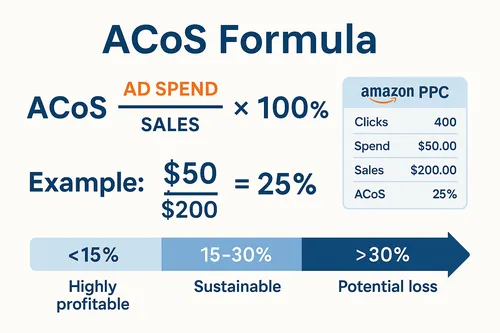
What is TACoS?
Total Advertising Cost of Sale (TACoS) takes a broader view by measuring your ad spend against your total Amazon sales—both organic and paid. This metric reveals how your advertising efforts influence your overall business performance.
The formula is:
TACoS = (Ad Spend ÷ Total Sales) × 100%
Let’s illustrate with an example: If you spend £100 on advertising, generate £500 in direct ad sales, but your total sales (including organic) are £1,000, your TACoS would be:
(£100 ÷ £1,000) × 100% = 10%
This indicates you’re spending 10% of your total revenue on advertising.
The Fundamental Differences
While both metrics measure advertising efficiency, they tell different stories about your business:
| Aspect | ACoS | TACoS |
|---|---|---|
| What it measures | Ad spend vs. ad-attributed sales | Ad spend vs. total sales (organic + paid) |
| Available in Amazon | Yes, directly in dashboard | No, requires manual calculation |
| Best for measuring | Campaign-level efficiency | Overall business impact of advertising |
| Sensitive to | Click-through rate, conversion rate | Brand awareness, organic ranking improvements |
| Blind spots | Ignores organic sales lift from ads | Can be skewed by strong organic performance |
| Primary use case | Optimizing ad campaigns | Evaluating advertising’s impact on total business |
The key distinction: ACoS is campaign-focused, while TACoS is business-focused.
ACoS answers: “How efficiently are my ad campaigns generating direct sales?”
TACoS answers: “How are my advertising investments affecting my overall business performance?”
Part 2: When to Use Each Metric
The ACoS-TACoS Decision Framework
Choosing the right metric depends on your specific situation. Here’s a practical framework to guide your decision:
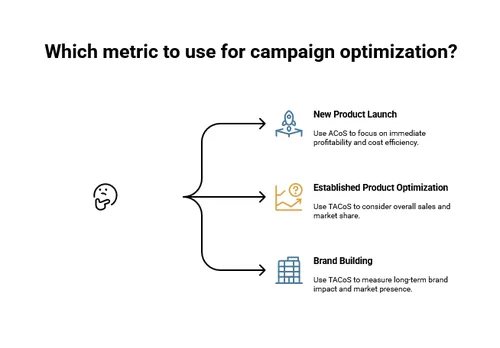
When ACoS is the Better Metric
ACoS should be your primary focus when:
1. Launching New Products During the initial launch phase, you’re primarily concerned with generating those first sales and reviews. Organic visibility is minimal, making direct ad performance crucial.
2. Optimizing Campaign-Level Performance When fine-tuning individual campaigns, ad groups, or keywords, ACoS provides the granular feedback needed to make tactical adjustments.
3. Managing Short-Term Profitability If cash flow is tight and you need to ensure immediate profitability on ad spend, ACoS gives you the direct insight into campaign-level ROI.
4. Conducting Keyword-Level Analysis ACoS helps identify which specific keywords are converting efficiently, allowing you to allocate budget more effectively.
A real-world example: One of my clients selling premium kitchen knives maintained strict ACoS targets of 15% during their Q4 holiday promotions to ensure profitability during their highest-volume sales period. By focusing on ACoS for this specific timeframe, they were able to maximize short-term profits while still capturing seasonal demand.
When TACoS is the Better Metric
TACoS becomes more valuable when:
1. Evaluating Brand Building Efforts If you’re investing in brand awareness campaigns, the benefits often appear as increased organic sales rather than direct ad attributions.
2. Measuring Long-Term Business Health TACoS provides a more holistic view of how your advertising contributes to overall business growth over time.
3. Tracking the Amazon Flywheel Effect As your advertising improves organic rankings, TACoS helps you monitor how ad spend drives total revenue growth beyond direct ad clicks.
4. Assessing Mature Product Performance For established products with significant organic sales, TACoS prevents you from undervaluing the indirect benefits of advertising.
Consider this case: An established home goods seller I worked with maintained a seemingly high ACoS of 35%, which initially appeared concerning. However, their TACoS was just 12% because their ads were significantly boosting organic sales through improved rankings. Focusing solely on ACoS would have led them to reduce ad spend, potentially damaging their overall business performance.
Part 3: Setting Targets and Benchmarks
Industry-Specific Benchmarks
Target metrics vary significantly across product categories. Here’s a breakdown of typical ranges based on my experience working with hundreds of Amazon sellers:
| Category | Target ACoS Range | Target TACoS Range | Notes |
|---|---|---|---|
| High-margin electronics | 15-25% | 5-10% | Higher price points allow for more aggressive advertising |
| Low-margin consumables | 10-15% | 3-7% | Thin margins require tighter ad control |
| Luxury/premium items | 25-40% | 8-15% | Higher margins support brand-building investment |
| Seasonal products | 30-50% (in season) 10-20% (off season) | 10-20% (in season) 5-10% (off season) | Requires adaptive targets based on seasonality |
| New product launches | 40-70% | 30-50% | Initial investment period to gain traction |
| Mature, established products | 15-25% | 5-10% | Focus on maintaining position efficiently |

Target Setting Strategy
Rather than blindly following industry averages, develop targets based on your specific business situation:
1. Calculate Your Break-Even ACoS Your break-even ACoS is determined by your profit margin:
Break-even ACoS = Profit Margin (%)
For example, if your product costs £20 to source, ship, and fulfill, and you sell it for £50, your profit margin is 60%. This means your break-even ACoS is 60%—anything below this generates profit on ad spend.
2. Determine Your TACoS Threshold Your TACoS threshold depends on your overall business goals:
- Growth-focused: Higher TACoS (15-25%) to capture market share
- Profit-focused: Lower TACoS (5-15%) to maximize returns
- Balanced approach: Moderate TACoS (10-20%) for sustainable growth
3. Implement Progressive Target Adjustment Start with more generous targets and gradually tighten them as your campaigns mature:
| Campaign Stage | ACoS Target | TACoS Target |
|---|---|---|
| Launch (Weeks 1-4) | Break-even + 20% | No specific target |
| Growth (Months 2-3) | Break-even + 10% | Monitor for baseline |
| Optimization (Months 4-6) | Break-even | 5% below initial TACoS |
| Maturity (6+ months) | 10% below break-even | 10% below initial TACoS |
This progressive approach allows you to build momentum before optimizing for efficiency.
Part 4: Practical Implementation
Tracking and Measurement Systems
One significant challenge with TACoS is that Amazon doesn’t provide this metric directly. Here’s how to implement effective tracking:
1. Amazon Advertising Console Limitations The native console only provides ACoS data. To calculate TACoS, you’ll need to combine data from multiple sources.
2. Manual TACoS Calculation Process At minimum, follow these steps:
- Export your Advertising reports from Amazon Advertising Console
- Export your Business reports from Seller Central
- Combine the data in a spreadsheet
- Calculate TACoS using the formula: (Ad Spend ÷ Total Sales) × 100%
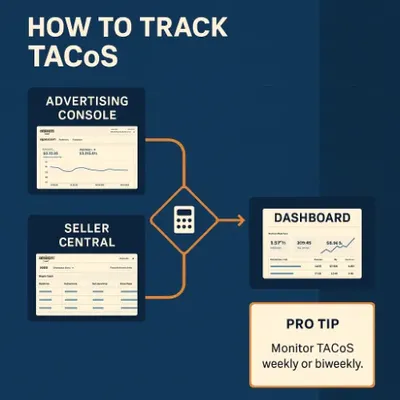
Case Studies: ACoS and TACoS in Action
Case Study 1: New Product Launch A kitchen gadget manufacturer launched a new garlic press with these results:
| Month | Ad Spend | Ad Sales | Total Sales | ACoS | TACoS |
|---|---|---|---|---|---|
| 1 | £2,000 | £3,000 | £3,200 | 67% | 63% |
| 2 | £2,500 | £5,000 | £6,000 | 50% | 42% |
| 3 | £3,000 | £8,000 | £12,000 | 38% | 25% |
Analysis: Initially, both ACoS and TACoS were high as expected for a new product. By month 3, the significant gap between ACoS (38%) and TACoS (25%) revealed that advertising was successfully generating organic sales through improved rankings and reviews.
Strategy: For new products, focus primarily on ACoS for the first month, then begin tracking TACoS from month 2 onwards to measure the flywheel effect.
Case Study 2: Mature Product Optimization An established home décor seller with a popular curtain rod set made these adjustments:
| Period | Ad Spend | Ad Sales | Total Sales | ACoS | TACoS |
|---|---|---|---|---|---|
| Before optimization | £1,500 | £6,000 | £20,000 | 25% | 7.5% |
| After cutting ad spend | £750 | £3,500 | £15,000 | 21% | 5% |
| After restoring ad spend | £1,500 | £6,000 | £22,000 | 25% | 6.8% |
Analysis: When they cut ad spend to improve ACoS, their total sales dropped significantly. Despite achieving a better ACoS (21%), their TACoS actually worsened because the reduced ad visibility impacted organic sales. Restoring the ad spend brought back the total sales volume.
Strategy: For mature products, prioritize TACoS over ACoS to avoid undermining the organic sales that advertising helps generate.
Part 5: Advanced Optimization Strategies
The ACoS-TACoS Balancing System
Rather than viewing these metrics in isolation, use them together in a complementary system:
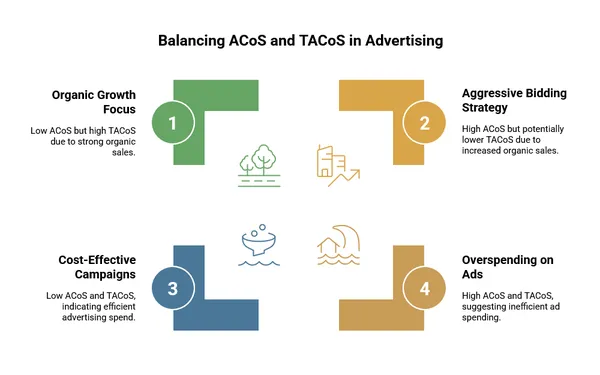
1. Simultaneous Optimization Approach Monitor both metrics on different timeframes:
- Daily/Weekly: Focus on ACoS for tactical adjustments
- Monthly/Quarterly: Evaluate TACoS for strategic decisions
2. Weighted Performance Indicators Create a combined score based on your business priorities:
- Growth phase: 30% ACoS weight, 70% TACoS weight
- Profit phase: 70% ACoS weight, 30% TACoS weight
3. Seasonal Adjustment Tactics Adjust your focus seasonally:
- Peak season: Prioritize ACoS to maximize direct returns during high-volume periods
- Off-peak: Shift focus to TACoS to build organic momentum for the next peak
Integration with Other Key Metrics
To gain a complete picture, integrate ACoS and TACoS with these complementary metrics:
1. CTR and Conversion Rate Correlation
- Low CTR + High ACoS = Ad creative problem
- High CTR + High ACoS = Listing conversion problem
- Monitor how improvements in these metrics affect your TACoS over time
2. Impression Share Impact
- Track how your impression share correlates with TACoS
- Increasing impression share often improves TACoS even if ACoS remains constant
3. New-to-Brand Metrics Alignment
- High New-to-Brand percentage + High ACoS = Acceptable for customer acquisition
- Monitor how New-to-Brand customers affect TACoS over 60-90 day periods
4. ROAS and Profit Margin Integration Create a unified dashboard that includes:
- ACoS (campaign efficiency)
- TACoS (business impact)
- ROAS (return on ad spend)
- Net profit margin (bottom-line impact)
This integrated approach provides a comprehensive view of advertising performance.
The Future of Amazon Advertising Metrics
As Amazon’s advertising platform continues to evolve, so too will the metrics we use to measure success. Here are some emerging trends to watch:
1. Amazon’s Evolving Attribution Models Amazon has been gradually improving its attribution capabilities, moving beyond the simple last-click model. This evolution will provide more accurate insights into how your advertising affects both direct and organic sales.
2. The Rise of Incrementality Measurement Beyond ACoS and TACoS, incrementality testing (measuring the true lift in sales that wouldn’t have occurred without advertising) is becoming more accessible to sellers. This approach answers the critical question: “What additional sales did my advertising actually generate?”
3. AI-Powered Metric Analysis Machine learning algorithms are increasingly being used to identify patterns and correlations between advertising actions and business outcomes that go beyond simple cause-and-effect relationships.
4. Preparing for Platform Changes Amazon regularly updates its advertising platform, often introducing new metrics and deprecating others. Staying adaptable in your measurement approach is essential for long-term success.
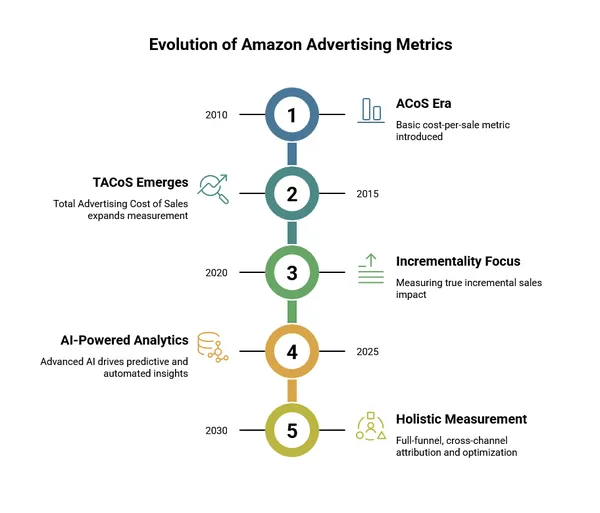
Conclusion: Making the Right Choice
The question isn’t really “ACoS vs TACoS - which is better?” but rather “When should I focus on each metric?”
ACoS excels at:
- Campaign-level optimization
- Short-term profitability management
- Keyword and targeting refinement
- New product launch phases
TACoS excels at:
- Overall business health assessment
- Long-term growth measurement
- Brand building evaluation
- Mature product advertising strategy
The most successful Amazon sellers I’ve worked with use both metrics in harmony, shifting focus based on their current business objectives, product lifecycle stage, and competitive landscape.
Start by establishing reliable tracking for both metrics, set appropriate benchmarks for your specific business, and develop a rhythm of reviewing each metric at the appropriate intervals. With this balanced approach, you’ll make more informed advertising decisions that drive both immediate returns and long-term business growth.